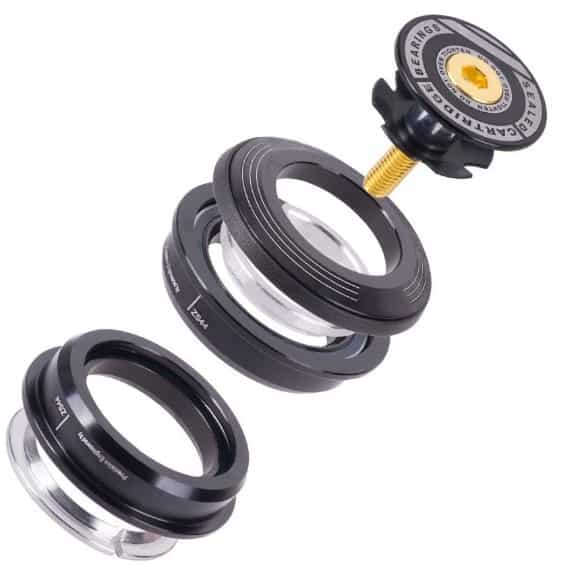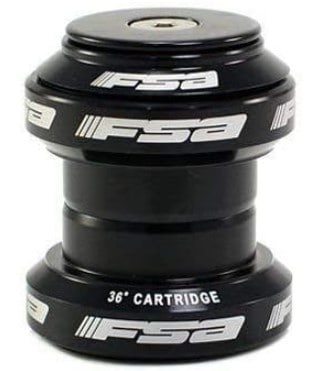Generally, the headset holds the fork perfectly in place and comes in handy when steering the bike. So, if it cannot perform its function well for whatever reason, replacing it may be a good idea. Are you asking, ‘when should I replace my bike headset?’
Replace your bike headset if it’s rusty, produces a creaking or grinding sound, or is moving unwantedly, what we call ‘Headset Play.’ Additionally, consider replacing it if it’s severely damaged or when replacing the fork.
I’ll explain all these issues to help you understand the subject better. We’ll also look at how you can replace the headset yourself if you opt to go that way.
But before that, let’s first understand what a bike headset is and what it does.
What is a bike headset exactly? What does it do?
A bike headset is what holds the fork to the bicycle frame. It rotates freely, depending on how you steer the bike.
So, its primary role is to allow you to steer the bike effectively. Though you can barely see a headset, its contribution is critical.
If the headset wears out or is improperly installed, for example, it’ll be hard to hold and control your bike.

When Should I Replace My Bike Headset?
Here are the key considerations:
1. Replace Your Headset if it’s Rusty
Rust is probably the biggest threat to your headset’s life. So, you cannot take it lightly. It’s widespread on the bearings and sometimes on the bearing cage.
Rust makes the headset stick, thus unresponsive to steering. In some extreme cases, rust causes the bearing cage to disintegrate.
But since you may not see the rust coat unless you observe keenly, consider taking the headset apart.
Pull out the bearings to inspect them. If you see any rust, scrub it off or clean it off with a cleaner like the Finish Line Super Bike Wash. If that works, then apply rust-proof grease to prevent rust from forming again.
But if you cannot remove the rust, consider replacing the bearings. Nevertheless, if the rust is extensive and tends to affect other parts, the best option is to replace the headset.
2. If It’s Moving Unwantedly (Headset Play)
If there’s excessive bearing play, the headset will move as it’s not supposed to. Often, this happens when the headset is too loose, and it’s primarily associated with one of its pieces changing its position. It can also occur when the stem loosens.
The good news is that a headset play is mostly fixable with tightening the headset. If that doesn’t work, then it’s likely that your headset has failed, and so you should replace it.
3. If It’s Damaged
You don’t have to wonder when to replace bike headset if it’s already damaged. You already have the sign!
If your headset is severely damaged, the chances are that it’ll become unresponsive. You have to watch out for direct damage to the bearings, seals, and cups.
If any of these parts are severely damaged, consider getting a new headset.
4. If It Produces a Grinding or Creaking Sound
Always watch out for weird sounds emanating from the headset. In particular, watch out for a clicking or grinding sound.
The creaking sound could be due to an extensively dirty headset, more so the bearings. So, before you can take any major step, first clean the headset with an effective bike lubricant like the WD-40 Specialist Lube.

If that doesn’t stop the weird sound, it could be that the headset has outlived its age. It happens when the headset is more than five years. In such a case, your option is to replace it.
As for the grinding sound, check for signs of rust as it causes rough grinding. If the rust is only minor, you can clean it off with an effective anti-rust cleaner.
But if that doesn’t stop the grinding, then consider replacing the headset.
5. When Replacing Your Fork
Typically, the headset and the fork wear together. For that reason, it makes sense to replace the other when you replace one.
Why You Should Replace Your Bike Headset
The headset primarily holds the fork to the bicycle frame to allow you to steer the bike comfortably. If your headset is faulty, you won’t be able to control your bicycle correctly.
The danger of an unresponsive headset is that you could quickly lose control of the bike. And even if you don’t, you won’t enjoy your cycling as the steering will be stiff and uncomfortable.
So, you should replace your headset to ensure it’s always responsive to the steering. That, in the long run, ensures that you can cycle comfortably and safely.
Do Bike Headset Have An Expiry? How Long Does A Bike Headset Last?
Headsets wear over time, and it all depends on two things; the riding condition and level of service.
If you ride your bike in perfect condition (dry, less rugged surface), your headset can last you two years or more, depending on the level of service.
If you regularly service your headset, it shouldn’t surprise you if it lasts five years or more.
In contrast, if you ride in wet conditions, it may be hard for your headset to last you a year. It’s more likely to go for 2-3 months.
How to Replace Bicycle Headset
Before you can replace your bike headset, ensure you have the right supplies. That includes:
- New bike headset (click here to check out the best bicycle headsets on Amazon)
- Two wrenches (adjustable wrench and regular wrench)
- Hammer
- Washers
- Screwdriver
- New bolt
- Bike grease
Once you have the right supplies, follow these steps to replace your bicycle headset:
- Using the adjustable wrench, hold the race down and hammer it
- Continue turning the adjustable wrench as you hammer the race down
- Use the hammer and screwdriver to tap out the headset cups to detach your old headset
- Remove your old headset and then grease the headtube cap
- Tighten the headtube bolt as your drive the new headset cups
- Do it gently to ensure you don’t crumple your headtube by over-tightening it
- Now assemble the rest of the headset
- Ensure you grease each bearing before fitting it in place
- Insert the fork before tightening the top cap
Congratulations! You just replaced your bike headset.

FAQs
1. Can I Change My Bike Headset?
Nowadays, headset replacement is no longer a job only left for bike repair experts. You can change your bike headset on your own at home.
Just get an affordable headset and follow the manufacturer’s instructions or online tutorials to fit it.
2. How Long Should A Bike Headset Last?
Depending on how often or aggressively you ride your bike, a headset can last months or years. For example, if you ride your bike in wet weather, your headset will likely get damaged by mud, which means it’ll last only a few months.
But if you ride under favorable, dry conditions, your headset could last two years or more, depending on the level of service.
3. How Do I Replace My Bike Headset?
You can replace your bike headset by following these steps:
- Hold down the race using a wrench and hammer it down
- Continue turning the wrench and hammering the race
- Tap out the cap to detach and remove your old headset
- Grease the headtube cups and then place the headset cups in place
- Tighten everything using the original orientation
- Insert the fork before tightening the top cap
4. How Long Does An MTB Headset Last?
If you ride your MTB in dry conditions and regularly service your bike, the headset can last you two years or more.
But if you cycle on mud and rarely service your MTB, you’ll be lucky if the headset lasts you more than three months.
5. When Should I Replace My Headset?
If your headset is experiencing unwanted movements, you should replace it. And if the headset bearings or cage are extensively rusty, you should replace the headset.
Also, watch out for a grinding or creaking sound emanating from the headset. Such weird sounds show that the headset is defective and needs replacing.
Don’t forget to replace your headset when replacing the fork. The two components are a pack.
6. How Do I Choose A Bike Headset?
Here are the general tips for getting the best bike headset:
- Determine the headset type that you have – integrated or press-fit
- Measure the headtube inside diameter
- Determine the measurement of your fork (top and bottom outside diameter)
- Write everything down and then look for a headset that matches the stats
You can compare the stats with the headsets you find online or do a random search on the internet.
Relevant:
Closing Thought:
So, when should I replace my bike headset? Watch out for rusty bearings, unusual headset movement, direct damage on the headset, or grinding or clicking noise.
All those are signs of a failing headset whose fix is to replace it.